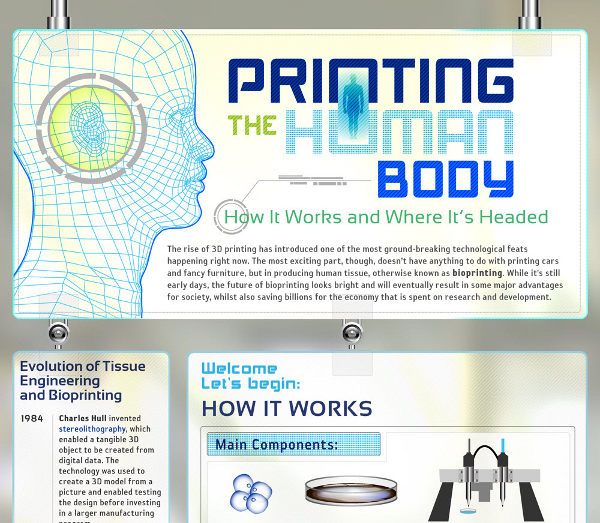A Bioprinting Infographic
Bioprinting is one of the many applications of 3D printing, a family of automation technologies for building three-dimensional structures from a blueprint. Living tissue is only different from other forms of automated fabrication by virtue of being much more complicated and somewhat more fragile. On the other hand, cells in a structure can self-assemble to some degree if the initial printed structure, chemical signals, and types of cell used are close enough to the final goal. So the challenges in printing tissue - and eventually in printing organs - are focused on trying to produce structures sufficiently close to living tissue for the cells involved to finish up on their own and close the gap. Creating a sufficiently comprehensive network of blood vessels to allow printed tissue to sustain itself is a big issue, for example.
At the end of this road, not so many years away, lies the goal of organ printing: producing complex organs for transplant on demand, grown from a patient's own cells. What effect this will have on life span remains to be seen, but on its own it is unlikely to be as large as we would like: probably incremental rather than revolutionary. You might look on it more in the way of taking conventional medicine for organ damage to the next level: expanding the number of people who can be treated, increasing the success rate of treatments, but suffering from many of the same limitations when it comes to the ability to successfully treat very elderly and frail people. There will probably be modest incidental benefits to life expectancy, just as there are for most broad improvements in medical technology. But you can have organs replaced as much as you like, and still age to death if there is no way to treat mitochondrial damage, build up of aggregates, aging in the brain, and so forth.
Surgery is never a desirable thing to have happen to you, especially if you are frail enough to need a transplant. This is one of the reasons why I suspect that stem cell medicine will ultimately gravitate to methods for inducing repair, regeneration, and rejuvenation in situ. They will either manipulate existing stem cells or infuse cultured stem cells taken from the patient, but these will be minimally invasive procedures that produce little to no trauma in the way that a transplant does.
In any case, back to bioprinting: I was recently pointed to an infographic on bioprinting, which looks at the high points of present development in the field. Click on it the thumb below for the full sized version:
Printing technology has come a long way in the 21st century, moving swiftly from two dimensional into the realm of 3D. Furniture,cars, shoes, a replica of King Tutankhamun - these are all things that have been made with 3D printing technology. However, it doesn't stop at material objects. In fact, using modified printer cartridges and extracted cells as the basis, scientists have a discovered a way in which to print human tissue. While this amazing concept is still at an early stage, the future of bioprinting (as it's commonly known) will allow for full organs and other human parts to be printed on demand for patients. Such a possibility will eventually wipe out the need for donor organs, which is a problem today considering the vast amount of patients in need of new organs.Being ever enthusiastic about advances in print technology, our creative team at PrinterInks decided to develop an infographic about this hot topic with the help of US based start-up Organovo; who are responsible for paving the way in bioprinting. Using Organovo's expertise, we developed an infographic to portray how the process works, as well as highlight today's organ transplant figures and the importance of how much money is concentrated on research and development for drug testing each year.
